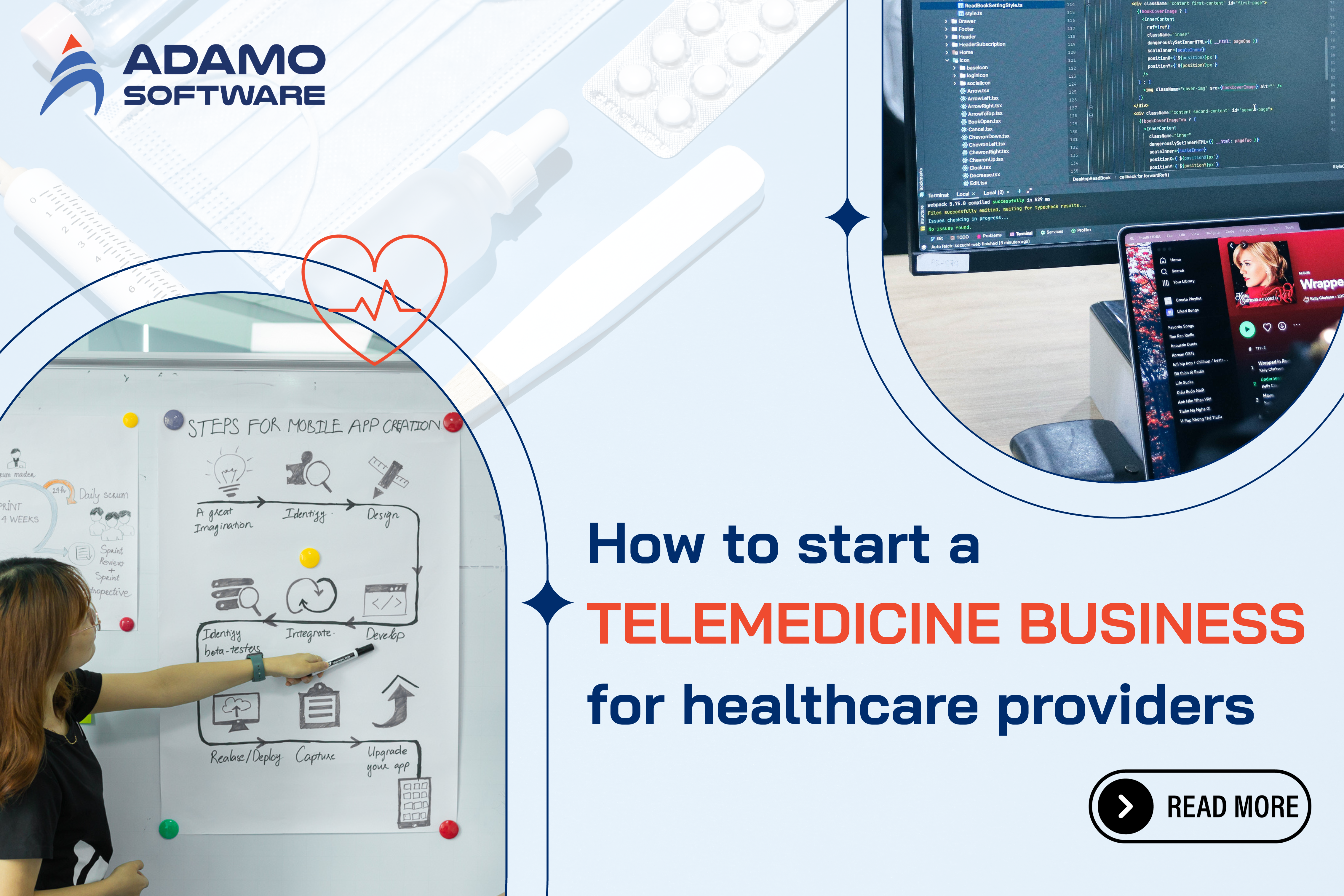How to start a Telemedicine Business model for Healthcare Providers

Telemedicine business model are designed to meet certain HealthTech company standards, including market competition and value addition for users.
Intent on establishing your telemedicine business? As a business that is highly regulated and extremely competitive, you must be wary of numerous aspects. The telemedicine business model relies heavily on the integration of telehealth software, including telepharmacy software, to facilitate remote consultations and medication management for patients in a variety of healthcare contexts.
With the advent of telemedicine business, new practices now have access to a valuable resource that can considerably improve their operations and patient care. This article examines the significance of telemedicine business for new practices and emphasizes the advantages it offers to both healthcare providers and patients.
I. Telemedicine business: An Overview
1. A big picture of telemedicine financial model
According to research, 53% of patients cancel their scheduled appointments due to extended wait times. In addition, individuals living in rural areas have no access to medical care. Either these patients reside too far away or there are insufficient physicians in the area. In simpler terms, it is difficult for some individuals to obtain the necessary medical and healthcare services.
These situations indicate a significant divide between healthcare providers and patients that limits them from accessing medical assistance. In such situations, nothing is more beneficial than telemedicine. Custom healthcare software development and telemedicine to facilitate communication between healthcare providers and patients.
Because 76% of patients are interested in obtaining services via telemedicine, the telemedicine business has become an exceptional investment opportunity for startups and entrepreneurs.
2. Business model for Telemedicine: Solutions on the market
The telemedicine business market consists of such elements:
- As software
- Hardware
- And services.
In terms of end-users, this market is segmentable as follows:
- Providers
- Payers
- Patients
- And additional end-users.
The IBIS World market research report outlines numerous areas of telehealth activity:
- Facilitating communication between patients and medical professionals
- Providing communication between providers
- Offering services for video conferencing
- Providing remote patient monitoring in both directions
- The transmission of digital medical imaging data
- Transferring digital medical information
- Communicating healthcare education materials.
II. Tremendous benefits of medicine for patients and service providers
1. Improved access to specialist care
Most patients in rural areas lack access to specialized healthcare, and in some cases, they lack access to healthcare altogether. In addition, physicians have limited means of communicating with healthcare-seeking patients. Nevertheless, developing a medical app with a telemedicine business feature can bridge this divide.
2. Lower expenses & costs
Telemedicine has the direct advantage of lowering healthcare costs. Initially, travel and transportation costs will be eliminated, and a telemedicine business will eliminate the need for an inpatient hospital stay, resulting in energy savings for healthcare institutions.
3. Better health outcomes
Telemedicine businesses can enhance patient engagement in healthcare, thereby substantially enhancing healthcare outcomes. According to research, telemedicine reduced hospital admissions and readmissions by 31% and 38%, respectively.
4. Increased efficiency
The purpose of the telemedicine business is to enhance the doctor-patient relationship; it cannot replace in-person care. The physicians can provide in-person appointments, but telemedicine offers flexibility and convenience for follow-up visits, checkups, and awareness sessions.
Explore the article of guide to EMR integration in healthcare application.
III. Challenges of telemedicine implementation in real cases
It can be difficult to implement a telemedicine business model because the central platform allows patients to communicate with doctors on any internet-connected device. For this reason, as a telemedicine software development company, you’ve to ensure that the telemedicine app is implemented correctly.
To assist you, we will discuss several obstacles associated with implementing a financial or business model for telemedicine.
1. Higher cost
Initially, telemedicine businesses can be expensive. Multiple products on the market start at $1000 to implement in a healthcare organization, but some cost as little as $100 with add-ons. The less expensive solutions are not user-friendly and require multiple add-ons to provide the necessary features.
In most instances, clients do not comprehend the gravity of the costs and attempt to negotiate a lower price. Nevertheless, discussing costs can be challenging.
2. License requirements
When it comes to implementing healthcare solutions, each state and country has its licensing requirements and regulations. The telemedicine business facilitates the crossing of state lines, which frequently results in penalties. The solution is to become familiar with the licensing policies and regulations for telemedicine business in your locations of service.
3. EMR integration
Integration of telemedicine with EMR is among the greatest obstacles. Most telemedicine businesses are currently being curated for EMR integration, but some still cannot provide the solution. Acquiring and storing patient information from previous encounters is the objective of EMR integration and healthcare app development.
To solve this problem, companies must collaborate with physicians to develop telemedicine software that supports EMR integration. This will ensure that physicians have access to the most up-to-date patient records and can provide the most reliable healthcare services.
IV. Which telemedicine business model for you?
1. B2B2C (Business-to-Business-to-Consumer)
Payers must have payment options for both new and existing telemedicine app development firms. The B2B2C model exists for this purpose alone. In this model, vendors first contact employers and payers directly, then, after both parties sign a business agreement, vendors begin marketing their telemedicine business product to the consumer market of the payer.
A CTO of a telemedicine business approaches the directors of healthcare organizations, insurance companies requiring telemedicine apps to manage claims/reimbursements, or private clinics for collaboration, and then targets their patients to sell telemedicine apps. Mobile companies such as Apple that collaborate with online retailers such as Amazon to offer their products to consumers could serve as a real-world example.
In addition, in the B2B2C model, vendors are compensated a small quantity per user regardless of whether that user utilizes the telemedicine product. Following this model can be frustrating at times because vendors may go months without a contract or encounter telemedicine business implementation challenges such as security.
Currently, the B2B2C strategy is gaining significant market traction, so the entry barrier has also increased. No longer are business meetings permitted without a HIPAA compliance audit and a HITRUST certificate.
2. B2C2B (Business-to-Consumer-to-Business)
B2C2B market strategy begins with marketing a product directly to a company’s employees or directly to consumers. These consumers function as influencers and assist with product promotion. Once a product achieves a sufficient level of popularity, the likelihood of companies collaborating increases. The objective of healthcare technology companies is to form a partnership with a paying organization. LinkedIn is one example of the B2C2B business model. Initially marketed as a free platform for professionals, LinkedIn now offers premium packages for those wishing to create business or company profiles.
B2C2B is a go-to-market strategy because it focuses on user acquisition and growth control. To accomplish user growth, digital health companies must develop telemedicine applications that address the most pressing user issues. The end-users determine if the telemedicine business is worthwhile, and only then will prestigious organizations be interested in collaborating.
3. Platform Business Model
The platform business model is most effective for organizations whose objective is not to sell a product, but rather to collaborate with a service provider who facilitates interactions on a platform fueled by the organization. Platform enterprises can generate revenue through advertising, access fees, usage fees, or any other means.
From the platform paradigm, one can derive the telemedicine business model. Since the beginning of the pandemic, the demand for on-demand healthcare services, virtual care, and remote care has increased. The application of telemedicine enables physicians to provide services to patients remotely. Users can utilize telemedicine applications from the comfort of their own homes, and physicians can earn additional income by working from anywhere.
In addition, healthcare software development firms can integrate emerging technologies such as big data and AI with telemedicine business platforms to improve patient care and diagnosis. AI algorithms analyze patient data, and the analysis results help physicians to use preventive and predictive strategies to improve patient outcomes.
4. Outsourced Virtual Care Network Models
The formation of a virtual provider network is a challenging endeavor for healthcare development firms. Developing a comprehensive virtual physician network requires significant time, money, and resources. In such instances, outsourcing physician networks is the best option.
Companies can lease physician networks (a repository of virtual nurses and doctors) through a modification to telemedicine applications. Instead of directly employing clinicians who will offer their services in a telemedicine business, companies can leverage existing physician networks.
5. Telemedicine Payvider Model
Payvider is a combination of the terms Payer and Provider. Payviders strive to deliver cost-effective care, and as providers, they have complete control over the quality of the healthcare they offer. A payvider partnership also reduces financial risk, boosts profitability, and enhances health outcomes. Moreover, payers consider risk in terms of premiums, whereas providers consider risk in terms of the cost of patient care.
Care coordination must be strong for a payprovider model to be successful. The payprovider must maintain parity with the care provided to patients, keeping in mind complete accountability and transparency. This is where telemedicine applications come into play. Telemedicine applications strengthen care coordination and permit providers to monitor patient health.
Using payvider as a telemedicine business model is also effective because both the provider and payer operate on the same platform. For instance, healthcare providers and insurance companies collaborating to form a payvider model are both able to utilize the telemedicine platform.
V. Experts’ Tips to Launch Successful Telemedicine Software
Telemedicine businesses must ensure compliance with state-specific and HIPAA regulations. Before listing your telemedicine business for sale, consider the following factors.
- Consider the telemedicine business laws in your country or state, as they differ between states. Furthermore, you must review the reimbursement policies.
- You must comprehend the market position, analyze the major competitors’ pricing strategies, and determine what they are offering. This information will assist you in setting a competitive price that will attract the right business associates.
- Always research the features. For example, if you wish to offer asynchronous communication, you must provide secure data storage, whereas diagnostics solutions require HD images.
- Define the customer segment and establish the enterprise’s objectives. It is essential to add originality to your services and focus on solving socio-economic issues.
- Consider how your technological solutions can generate revenue. Specifically, you must define a revenue stream because each has a unique pricing model.
- Create a plan of action that incorporates business development activities.
Besides, you can explore the revolution of healthcare in Vietnam and other Southeast Asian countries.
VI. Adamo Software: Helps You Build Telemedicine App
The telemedicine app industry is growing and telemedicine startups are prospering. Due to the high demand, there are numerous opportunities to monetize telehealth and telemedicine applications.
It is time to construct a telemedicine application and enter the healthcare software development market. However, before diving in, you should realize that the business world is a treacherous path with concealed rocks and reefs. You don’t need to proceed blindly by trial and error, though.
Adamo Software, a premier software development company, will assist you in telemedicine software development as you take the first step toward establishing a telehealth enterprise.
VII. FAQs
1. What is the capital cost needed to launch a telemedicine app?
The money you need to transform your app concept into a functional telemedicine business is referred to as the capital cost, but it is not limited to app development costs.
The startup costs for a telemedicine business consist of the following:

The best aspect of capital cost estimation is its precision. The initial investment could be as little as $50,000. Here, I would like to emphasize that capital costs are highly dependent on the type of application, location, and business objectives.
Consequently, it will be different in your circumstances.
If you choose a while-label telehealth app as opposed to a custom app, however, I can guarantee that the capital cost will not exceed $50,000.
2. What is the operating cost of telemedicine business model?
As the term implies, operating costs are the expenses associated with the operation of a telemedicine business.
It contains,

With a capital cost of $35,000 and a monthly profit of $15,000, it would take you less than three months to break even.
It would take less than 4 months to attain break-even with a profit of $10,000. And with a profit of $5,000, it would take approximately seven months. If you are unable to perceive this, let’s see this example:
- $100 is required to establish a telemedicine app business.
- $50 is the monthly operating expense.
- $100 is the monthly revenue.
- $50 ($100 revenue – $50 operating cost) is the net monthly profit.
- 2 months ($50 + $50) are required to reach the initial investment (time to break even).
3. What is the telemedicine business model?
3.1. Key partners
- Doctors
- Pharmacists
- App development company
- HIPAA/PHIPA Consultant
3.2. Key activities
- App development & maintenance
- Customer support
- Compliance assessment
- App Marketing
- Users & doctors onboarding
3.3. Key resources
- Mobile app
- Customer support team
- Doctors
- Pharmacy
3.4. Value proposition
- Rapid care
- Quality care
- Licensed doctors
- Multiple communication modes
- Prescription delivery
- Healthcare access from home
3.5. Customer relationships
- 24/7 Active customer support
- Customer support chat
- Social media pages
3.6. Channels
- Mobile app
- Web portal
- Social media
3.7. Customer segments
- Elderly
- Working parents
- People seeking primary care
- People having chronic illness
3.8. Cost structure
- Pay per visit
- Membership
- Pay per employee
3.9. Revenue streams
- Patient visit
- Personal membership
- Family membership
- Company partner program
4. Legal and regulatory in Telemedicine implementation
This section will examine the legal and regulatory issues of telemedicine, including HIPAA compliance and data security, licensing requirements and state regulations, and reimbursement and insurance concerns.
4.1. HIPAA compliance and data security
The Health Insurance Portability and Accountability Act (HIPAA) establishes guidelines for safeguarding patient privacy and electronic protected health information (ePHI). Healthcare providers utilizing telemedicine business platforms must ensure that their selected software complies with HIPAA requirements, such as data encryption, secure transmission, access controls, and auditing capabilities. It is essential to implement appropriate privacy and security protocols, such as obtaining patient consent for telehealth services and training staff on EHR HIPAA compliance.
4.2. Licensing requirements and state regulations
Each state has its licensing requirements and regulations that telemedicine business practitioners must abide by to offer services. Each state has its regulations governing the practice of telemedicine, including requirements for licensure, the establishment of a physician-patient relationship, and prescribing restrictions. To ensure compliance, providers should familiarize themselves with the telemedicine laws and regulations in the states where their patients reside.
4.3. Reimbursement and insurance considerations
The reimbursement policies for telemedicine businesses vary between private insurance companies, Medicare, and Medicaid. Providers should familiarize themselves with the reimbursement policies specific to each payer and be aware of the services and conditions that qualify for reimbursement. To ensure accurate reimbursement, it is essential to document telemedicine encounters appropriately, including coding and invoicing. To maximize financial viability and patient access to telemedicine business services, it is essential to remain current on reimbursement policy changes.











